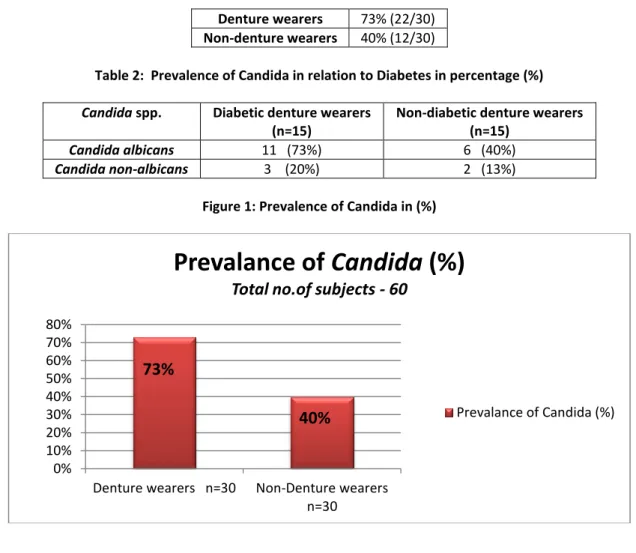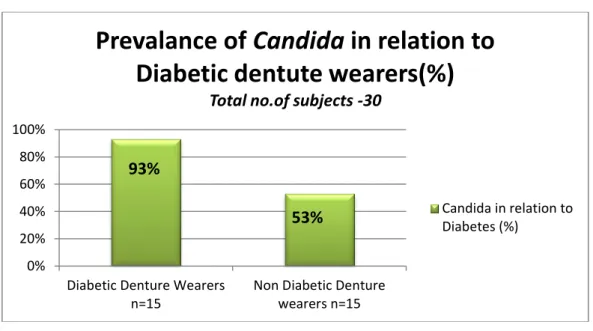Research Journal of Pharmaceutical, Biological and Chemical
Sciences
Prevalence of Candida among Denture and Non Denture Wearers.
Divya Rani M1, Surya Prabha P1, Lakshmipriya R2*, and Chitralekha S1.1Sree Balaji Medical College, Chromepet, Chennai, Tamil Nadu, India. 2
ESIC medical college and PGIMSR, K.K.Nagar, Chennai, Tamil Nadu, India.
ABSTRACT
To assess the prevalence of Candida spp. among denture and non-denture wearers. To study the prevalence of Candida spp. among denture wearers in relation to Diabetes mellitus. A total of 60 individuals were enrolled in the study. Of the subjects, 30 were denture wearers (15 - Diabetic and 15- non diabetic) and 30 were non-denture wearers. The salivary samples are collected by oral rinsing technique. Each subject was instructed to perform an oral rinsing using phosphate-buffered saline (PBS) for 60 seconds and the salivary samples were collected in sterile containers. The samples were processed immediately in Sabouraud’s dextrose agar (SDA) and incubated at 37⁰C for 48 hours for the recovery of Candida spp. Out of the 60 subjects the prevalence of Candida spp. was 73% in denture wearers and 40% in non-denture wearers. The prevalence of Candida spp. in relation to Diabetes mellitus was 93% in Diabetic denture wearers and 53% in non-diabetic denture wearers. The rate of Candidal growth was higher in denture wearers and it was more frequently identified in denture wearers with Diabetes when compared to non-diabetic denture wearers.
Keywords: Candida, Denture wearers, Diabetes, poor oral hygiene.
INTRODUCTION
There are about 300-400 species of micro-organisms and 20 species of Candida in the oral cavity [1]. Most of the yeast infection in the oral cavity is caused by the genus
Candida. Any changes in the oral cavity, such as tooth loss and denture wearing will cause changes in the oral micro flora [2]. Candida is recognized as a normal commensal of almost half of the population which does not cause any harmful effects [3,4]. But Candida can become a pathogen during favourable conditions. Immuno-compromised status like diabetes, trauma caused by the prosthesis due to ill filling dentures, nocturnal wear of the denture, age of the denture, other systemic conditions and unhygienic maintenance of the dentures by the patient are few of the causative agents which makes the oral cavity unhealthy and suitable environment for Candida to turn pathogenic resulting in oral candidiasis[5].
Oral Candidiasis is an opportunistic infection which causes pathological changes in the mucosal surface of the oral cavity [6,7]. This is due to the prosthesis that acts as a focus and trauma caused by the denture facilitates the infection [5]. Candidiasis may appear as various symptoms including pain, burning sensation, difficulty in swallowing, change of taste, but often they are asymptomatic [8]. About 50- 65 % of patient wearing dentures have been reported to have over growth of oral Candida [1], leading to Candida associated denture stomatitis (inflammation of the denture bearing site of the mucosa). Oral candidiasis has also been reported to have strong association with lung candidiasis and deglutition pneumonia [9] . It was recorded in the U.S between the year 1995 and 2002 that among the nosocomial blood stream infections 9.5% were fungal organisms with Candida
species being the fourth leading cause of all cases [10] .
Denture wearing constitutes a stable factor which can affect the oral health. This should be taken into consideration while making predictions and assessing oral health management. Therefore in this study we have compared the prevalence of Candida among denture and non-denture wearers. As per literature there is a significant higher total count of Candida species in denture wearers compared to non-denture wearers. We have also compared the prevalence of Candida among denture and non-denture wearers in relation to Diabetes.
MATERIALS AND METHODS
A total of 60 subjects participated in the study. Thirty subjects were denture wearers (15- diabetic and 15- non-diabetic) at least for past one year, comprised the experimental group and thirty subjects were non-denture wearers comprised the control group. All subjects were patients selected from the outpatient section of the department of prosthodontics, SBDCH, Chennai.
Patient included in the study are denture and non-denture wearers, diabetic denture wearers, patient belonging to the age group between 40-80 years both male and female. An exclusion criterion includes smokers, patient who are already treated or currently taking antibiotics, antifungal, steroids or immunosuppressive drugs in the past six months.
Patients were clearly explained about the purpose of the study, followed by a detail medical and dental history was collected. The informed consent was obtained from the subjects.
Sample collection
The salivary samples were collected by oral rinsing method [11]. Each subject was instructed to remove their dentures and perform an oral rinsing using phosphate-buffered saline (PBS) for 60 seconds and the salivary samples were collected in sterile containers. The samples were immediately transported to the Microbiology laboratory.
Each oral rinse was centrifuged at 3500 rpm for 10 minutes. The supernatant was discarded and the concentrated oral rinse was then inoculated in Sabouraud’s dextrose agar (SDA) and incubated at 37⁰C for 48 hours for the recovery of Candida spp.
RESULTS
Out of the 60 subjects the prevalence of Candida was 73% (n=22) in denture wearers and 40% (n=12) in non-denture wearers (Table 1). The prevalence of Candida in relation to diabetes was 93% (n=14) in diabetic denture wearers and 53% (n=8) in non-diabetic denture wearers. Candida albicans was the most commonly isolated species in both the groups.
Table 1: Prevalence of Candida in percentage (%) Denture wearers 73% (22/30)
Non-denture wearers 40% (12/30)
Table 2: Prevalence of Candida in relation to Diabetes in percentage (%)
Candida spp. Diabetic denture wearers (n=15)
Non-diabetic denture wearers (n=15)
Candida albicans 11 (73%) 6 (40%)
Candida non-albicans 3 (20%) 2 (13%)
Figure 1: Prevalence of Candida in (%)
0% 10% 20% 30% 40% 50% 60% 70% 80%
Denture wearers n=30 Non-Denture wearers n=30
Prevalance of
Candida
(%)
Total no.of subjects - 60
Prevalance of Candida (%)
73%
Figure 2: Prevalence of Candida in relation to Diabetes (%)
DISCUSSION
The sole factor of this study is Denture wearing increases the Candidal colonization in the oral cavity and its growth rate was found higher in Diabetic denture wearers when compared to non-diabetic denture wearers due to their immuno-compromised status. There was a significant correlation between the duration of denture usage and the blood glucose level.
In our study there was a higher oral Candidal growth in denture wearers (22/30) when compared to non-denture wearers (12/30). In relation to diabetes the Candidal growth was increased in diabetic denture wearers (14/15) when compared to non-diabetic denture wearers (8/15). The most commonly isolated species in the both the groups was Candida albicans. A similar trend of result was observed Mohammad Hossein Lotfi-Kamran et al [12] and other investigators [13-16] that Candidal carriage was higher in denture wearers with diabetes.
CONCLUSION
Immuno-compromised status like diabetes, trauma caused by the prosthesis due to ill filling dentures, nocturnal wear of the denture, age of the denture, and unhygienic maintenance of the dentures by the patient are few of the causative agents which makes the oral cavity unhealthy and suitable environment for Candida to turn pathogenic resulting in oral candidiasis[17].
Candida infection is more common among denture wearers and it is strongly associated with diabetes, hence controlling serum glucose level is essential. Unclean dentures are a chronic source of potentially harmful bacteria and fungi that may be associated with oral and systemic diseases.
Dentures need to be cleaned daily with effective antimicrobial and antifungal agents but there comes a time when a denture can no longer be cleaned effectively and must be replaced. So better oral hygiene is necessitated among denture wearers.
0% 20% 40% 60% 80% 100%
Diabetic Denture Wearers n=15
Non Diabetic Denture wearers n=15
Prevalance of
Candida
in relation to
Diabetic dentute wearers(%)
Total no.of subjects -30
Candida in relation to Diabetes (%) 93% 53%
REFERENCES
[1] Hiroyuki Mizugai, Emiko Isogai, Kimiharu Hirose, Itsuo Chiba. J App Res 2007; 7(3). [2] Sumi Y, Nagaosa S, Michiwaki Y, et al. J J Gerodont 2001;16:171-178.
[3] Arenforf TM, Walker DM. Brit Dent J 1979; 147:267-272. [4] Arenforf TM, Walker DM. Arch Oral Biol 1980; 25:1-7.
[5] E Emami, P de Grandmont, PH Rompré, J Barbeau. J Dental Res 2008;87(5):440- 444. [6] Gonsalves WC, Chi AC, Neville BW. Am FAM Physician 2007; 75:501-7.
[7] Ben-Aryeh H, Berdicevsky I, Gutman D, Szargel R. Int J Oral Surg 1980; 9:113-5. [8] Samaranayake LP. Host factors and oral candidiasis. In: MacFarlane TW,
Samaranayake LP, editors. Oral candidosis. London: Butterworth & Company Ltd; 1990. P.66-103.
[9] Honda E, Mutoh T, Maeda N, et al. J J Gerodont 2000; 14:297-306.
[10] Wisplinghoff H, Bischoff T, Tallent SM, Seifert H, Wenzel RP, et al. Clin Inf Dis 2004;39:309–317.
[11] Coulter WA, Kinirons MJ, Murray SD. Int J Paediatric Dent 1993; 3:17-21.
[12] Mohammad Hossein Lotfi-Kamran, Abbas Ali Jafari, Abbas Falah-Tafti, Ehsan Tavakoli, Mohammad Hossein Falahzadeh. Dental Res J 2009;6(1).
[13] Willis AM, Coulter WA, Fulton CR, Hayes JR, Bell PM, Lamey PJ. Diabet Med 1999; 16(8): 675-9.
[14] Konsberg R, Axell T. Oral Surg Oral Med Oral Pathol 1994; 78(3): 306-11.
[15] Belazi M, Velegraki A, Fleva A, Gidarakou I, Papanaum L, Baka D, Daniilidou N, Karamitsos D. Mycoses 2005; 48: 192-6.
[16] Sahin I, Oksuz S, Sencan I, Gulcan A, Karabay O, Gulcan E, Yildiz O. Ethiop Med J 2005; 43: 103-9.

